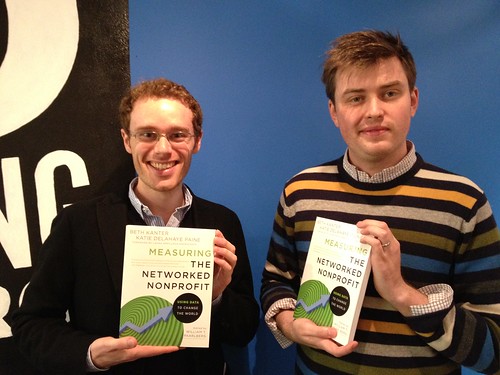
Meet Bib Filbon and Jeff Bladt who have the job title, “Data Scientist,” and are on staff at DoSomething.Org. They work in partnership with DoSomething’s program staff to collect, analyze, and make sense of data to improve impact of DoSomething’s programs. DoSomething.org does not consider this overhead. Building infrastructure, in-house expertise, and data literacy of all staff is critical to their success so they have invested.
“Data Scientist” is a newly defined job that requires being part data geek, analyst, communicator, visualizer, storyteller, and interpreter. This individual works with program experts to apply what is learned from the data. But they have also made data literacy an essential competency for everyone in the organization. The result is a shift from ad hoc data analysis and simple (though detailed) record-keeping to a systematic approach to improving their programs and campaigns by using data.
Most nonprofits do not have the resources to hire one of these in-demand professionals nor do you see many funding opportunities to build this type of commitment to measurement and learning from data into a nonprofit’s DNA.
As I go around and give presentations on the ideas of “Measuring the Networked Nonprofit: Using Data to Change the World,” with co-author KD Paine, I’m hearing a few repeated themes. One goes something like this, “Our organization has to collect a lot of data, mostly counting data for our funders. But that data doesn’t tell anything about how we can improve and get better results.”
@mmorino just finishing up talks in RI/Boston – some great discussions about measurement. What is funder’s role to support good measurement?
— Beth Kanter (@kanter) October 4, 2012
I was curious so I asked Mario Marino who wrote the book, Leap of Reason: Managing to Outcomes, about this issue. Here’s his response:
The reality is funders are not supporting good measurement—at least not measurement done by the nonprofits to manage their effectiveness and to outcomes. In Elizabeth Boris’s words “…they are missing in action.”
If you’ve not seen The Center for Effective Philanthropy survey of September, 2012, it sets up the challenge pretty clearly. The survey reported that more than 80% of nonprofit leaders say “nonprofits should demonstrate the effectiveness of their work by using performance measures,” and yet 71% say they receive no foundation support – monetary or otherwise — for their organization’s assessment efforts. That says volumes. This past March, I wrote this column for funders: For Grantees to Take the Leap, Funders Must Step Up, to discuss why nonprofits who want to make the leap to high performance need funders who are bold and creative enough to think big with them.
Now many funders have funded measurement via third-party evaluations and as a result think they’ve funded measurement . In my view, Edna McConnell Clark Foundation’s investment approach leads the field in funding a focus on performance (measurement), but do so comprehensively within a rigorously defined theory of change and helping the nonprofit have clearly defined outcomes and the metrics to assess those outcomes. We encourage the same with our investment approach in our placed-based approach with Venture Philanthropy Partners. And there are other intermediaries, e.g., REDF, New Profit, and a few others, supporting this as well in a substantive way. The St Luke’s Foundation in Cleveland realigned using the premises of Leap of Reason and has redefined its own role and purpose: Bigger Investments. Deep Commitments, Saint Luke’s Foundation’s 2011 Annual Report, which presents a bold approach to grantmaking anchored in outcomes and defined by “rethink, redesign and reinvent.” Finally, there are probably many more than fund “capacity building,” but too often, the level of funding, e.g., $10,000, is woefully inadequate and it is seldom supported with the relevant strategic assistance and expertise by the funder nonprofits need.
The challenge is to better convey the value of measurement to funders. All of us, like you’ve done with your book, need to provide solid, tangible demonstration of the value of high performance, based on measurement, that is done by the nonprofits themselves — and which is separate and distinct from third-party evaluations and external methods to assess or rate nonprofit performance. The irony is that if nonprofits had good measurement systems in would enrich third-party evaluations and external rating approaches! Kris Moore, Karen Walker, and David Murphey of Child Trends, expresses this well in this chapter from Leap of Reason — Performance Management: The Neglected Step in Becoming an Evidence-Based Program.
Probably a lot more than you wanted, but you’re hitting on one of the Achilles heels of the sector. The even bigger one, in my view, is the acute shortage of talent in the sector, which I just wrote about in I’ll Take Great People Over Great Models Any Day. After all, measurement is but a means to an end, and without the domain knowledge and judgment to use data, it remains just that – data, never becoming information, and certainly not evolving to knowledge.
Mario’s last point is something that I’ve wondered about in a recent guest post, “Doing the Math Ourselves” over at the Markets for Good site. What are the skills and mindsets that nonprofits need to embrace data for social change? What are the types of funding and capacity building that philanthropy should support to make this happen?
